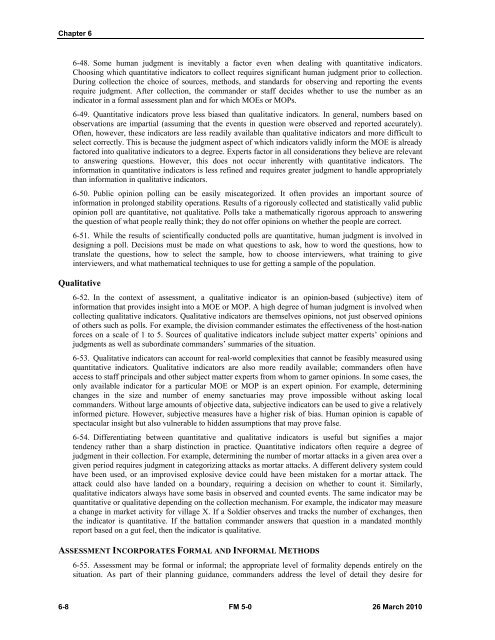FM 5-0, The Operations Process - Federation of American Scientists
FM 5-0, The Operations Process - Federation of American Scientists
FM 5-0, The Operations Process - Federation of American Scientists
Create successful ePaper yourself
Turn your PDF publications into a flip-book with our unique Google optimized e-Paper software.
Chapter 6<br />
6-48. Some human judgment is inevitably a factor even when dealing with quantitative indicators.<br />
Choosing which quantitative indicators to collect requires significant human judgment prior to collection.<br />
During collection the choice <strong>of</strong> sources, methods, and standards for observing and reporting the events<br />
require judgment. After collection, the commander or staff decides whether to use the number as an<br />
indicator in a formal assessment plan and for which MOEs or MOPs.<br />
6-49. Quantitative indicators prove less biased than qualitative indicators. In general, numbers based on<br />
observations are impartial (assuming that the events in question were observed and reported accurately).<br />
Often, however, these indicators are less readily available than qualitative indicators and more difficult to<br />
select correctly. This is because the judgment aspect <strong>of</strong> which indicators validly inform the MOE is already<br />
factored into qualitative indicators to a degree. Experts factor in all considerations they believe are relevant<br />
to answering questions. However, this does not occur inherently with quantitative indicators. <strong>The</strong><br />
information in quantitative indicators is less refined and requires greater judgment to handle appropriately<br />
than information in qualitative indicators.<br />
6-50. Public opinion polling can be easily miscategorized. It <strong>of</strong>ten provides an important source <strong>of</strong><br />
information in prolonged stability operations. Results <strong>of</strong> a rigorously collected and statistically valid public<br />
opinion poll are quantitative, not qualitative. Polls take a mathematically rigorous approach to answering<br />
the question <strong>of</strong> what people really think; they do not <strong>of</strong>fer opinions on whether the people are correct.<br />
6-51. While the results <strong>of</strong> scientifically conducted polls are quantitative, human judgment is involved in<br />
designing a poll. Decisions must be made on what questions to ask, how to word the questions, how to<br />
translate the questions, how to select the sample, how to choose interviewers, what training to give<br />
interviewers, and what mathematical techniques to use for getting a sample <strong>of</strong> the population.<br />
Qualitative<br />
6-52. In the context <strong>of</strong> assessment, a qualitative indicator is an opinion-based (subjective) item <strong>of</strong><br />
information that provides insight into a MOE or MOP. A high degree <strong>of</strong> human judgment is involved when<br />
collecting qualitative indicators. Qualitative indicators are themselves opinions, not just observed opinions<br />
<strong>of</strong> others such as polls. For example, the division commander estimates the effectiveness <strong>of</strong> the host-nation<br />
forces on a scale <strong>of</strong> 1 to 5. Sources <strong>of</strong> qualitative indicators include subject matter experts’ opinions and<br />
judgments as well as subordinate commanders’ summaries <strong>of</strong> the situation.<br />
6-53. Qualitative indicators can account for real-world complexities that cannot be feasibly measured using<br />
quantitative indicators. Qualitative indicators are also more readily available; commanders <strong>of</strong>ten have<br />
access to staff principals and other subject matter experts from whom to garner opinions. In some cases, the<br />
only available indicator for a particular MOE or MOP is an expert opinion. For example, determining<br />
changes in the size and number <strong>of</strong> enemy sanctuaries may prove impossible without asking local<br />
commanders. Without large amounts <strong>of</strong> objective data, subjective indicators can be used to give a relatively<br />
informed picture. However, subjective measures have a higher risk <strong>of</strong> bias. Human opinion is capable <strong>of</strong><br />
spectacular insight but also vulnerable to hidden assumptions that may prove false.<br />
6-54. Differentiating between quantitative and qualitative indicators is useful but signifies a major<br />
tendency rather than a sharp distinction in practice. Quantitative indicators <strong>of</strong>ten require a degree <strong>of</strong><br />
judgment in their collection. For example, determining the number <strong>of</strong> mortar attacks in a given area over a<br />
given period requires judgment in categorizing attacks as mortar attacks. A different delivery system could<br />
have been used, or an improvised explosive device could have been mistaken for a mortar attack. <strong>The</strong><br />
attack could also have landed on a boundary, requiring a decision on whether to count it. Similarly,<br />
qualitative indicators always have some basis in observed and counted events. <strong>The</strong> same indicator may be<br />
quantitative or qualitative depending on the collection mechanism. For example, the indicator may measure<br />
a change in market activity for village X. If a Soldier observes and tracks the number <strong>of</strong> exchanges, then<br />
the indicator is quantitative. If the battalion commander answers that question in a mandated monthly<br />
report based on a gut feel, then the indicator is qualitative.<br />
ASSESSMENT INCORPORATES FORMAL AND INFORMAL METHODS<br />
6-55. Assessment may be formal or informal; the appropriate level <strong>of</strong> formality depends entirely on the<br />
situation. As part <strong>of</strong> their planning guidance, commanders address the level <strong>of</strong> detail they desire for<br />
6-8 <strong>FM</strong> 5-0 26 March 2010















